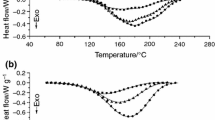Abstract
The thermal mechanical properties and degradation kinetics of Staybelite Resin, a thermoplastic, and its ester derivative Staybelite Ester 10 have been investigated using thermoanalytic methods. The thermogravimetric analyzer applied in the degradation studies has been interfaced with a minicomputer for data acquisition. The degradation kinetics of each thermosplastic have been satisfactorily attributed to an associated first-order process using a differential method.
The results indicate that the esterified resin has an improved durability over the original material with regard to thermal cycling between ambient temperature and 60°. This observation is consistent with the finding that the esterified resin was thermally more durable than Staybelite Resin for holographic recording use.
Résumé
On a étudié par les procédés thermoanalytiques les propriétés thermomécaniques et la cinétique de la dégradation de la résine thermoplastique Staybelite et de son dérivé éthérifié Staybelite Ester 10. L'acquisition des données s'est effectuée en couplant la thermobalance à un miniordinateur. A l'aide d'une méthode différentielle, on a pu attribuer d'une manière satisfaisante la cinétique de dégradation de chacune des deux résines thermoplastiques à un processus associé du premier ordre.
Les résultats indiquent que la résine éthérifiée possède une durée de vie supérieure à celle du matériau original en ce qui concerne le cyclage thermique entre la température ambiante et 60°. Cette observation est en accord avec le résultat selon lequel la résine éthérifiée résiste plus longtemps lors de l'enregistrement holographique que la résine Staybelite.
Zusammenfassung
Die thermischen mechanischen Eigenschaften und die Zersetzungskinetik des Harzes Staybelite, eines thermoplastischen Materials und seines Esterderivats Staybelite Ester 10 wurden unter Verwendung thermoanalytischer Methoden geprüft. Der bei den Zersetzungsuntersuchungen eingesetzte thermogravimetrische Analysator wurde zwecks Datensammlung mit einem Minikomputer gekoppelt. Unter Anwendung einer Differential-methode konnte die Zersetzungskinetik jedes der beiden thermoplastischen Materialien befriedigend einem assoziierten Vorgang erster Ordnung zugeordnet werden.
Die Ergebnisse zeigen eine verbesserte Beständigkeit des veresterten Harzes gegenüber dem Originalmaterial hinsichtlich der thermischen Zyklisierung zwischen Zimmertemperatur und 60°. Diese Beobachtung stimmt mit dem Befund überein, nach welchem das veresterte Harz im Einsatz bei holographischen Aufzeichnungen hitzebeständiger war als das Harz Staybelite.
Резюме
Исследованы, использ уя термоаналитическ ие методы, термические м еханические свойства и кинетика д еградации Staybelite Resin, термопл астика и его сложноэфирное производное Staybelite Ester 10. Термо гравиметрический анализатор, использу емый при изучении деграда ции, был соединен с мал ой вычислительной маши ной для сбора данных. Используя диф ференциальный метод, было установлено, что кине тика деградации каждого термопласти ка удовлетворительн о описывается каким-ли бо действующим проце ссом первого порядка. Резу льтаты показывают, чт о этерифицированная с мола, относительно теплового цикла от ок ружающей температур ы и до 60°, обладает большей сто йкостью по сравнению с началь ным материалом. Это на блюдение согласуется с найден ным, что этерифированная смола была термическ и более устойчивой при голог рафическом использовании, чем ис ходная — не этернифиц ированная смола.
Similar content being viewed by others
References
H. I. Enos, Jr., G. C. Harris andG. W. Hednick, Encly. Chem. Techn., 17 (1968) 475.
G. C. Harris andT. F. Sanderson, Am. Chem. Soc., 70 (1948) 334;ibid., 70 (1948) 339; ibid., 70 (1948) 2079; 70 (1948) 2081; G. C.Harris, ibid., 70 (1948) 3671; G. C.Harris and J.Sparks, ibid., 70 (1948) 3674; G. C.Harris and T. F.Sanderson, ibid., 70 (1948) 3870.
J. C. Urback andK. W. Meier, Appl. Opt., 5 (1966) 666.
L. H. Lin andH. L. Beauchamp, ibid., 9 (1970) 2088.
T. C. Bellamy, D. B. Ostrowsky, M. Poindron andE. Spitz, ibid., 10 (1971) 1958.
T. L. Credelle andF. W. Spong, RCA Rev., 33 (1972) 206.
W. C. Stewart, R. S. Mezrich, L. S. Cosentino, E. M. Nagle, F. S. Wendt andR. D. Lohman, RCA Rev., 34 (1973) 3.
T. C. Lee, Appl. Opt., 13 (1974) 888.
W. J. Smothers andY. Chiang, Handbook of Differential Thermal Analysis, Chemical Publishing Co., Inc., New York, 1966.
W. W.Wendlandt, Thermal Methods of Analysis, Interscience Publishers, 1964.
T. Daniels, Thermal Analysis, John Wiley & Sons, New York, 1973.
W. Y.Wen and M.Dole, Computer in Chemistry and Instrumentation Series, Vol. VI, J. S.Mattson, H. B.Mack, Jr. and H. C.MacDonald, Jr., Editors, (in press).
G. Romco, E. Lifshin, M. F. Ciccarelli andD. B. Soresen, Anal. Chem., 45 (1973) 2444.
E. Robens, Vac. Microbalance Tech., 8 (1971) 73.
L. Reich andS. S. Stivala, Elements of Polymer Degradation, McGraw-Hill Co., New York, 1971, p. 84.
A. E. Newkirk, Anal. Chem., 3 (1960) 1558.
C. B. Murphy, ibid., 36 (1964) 347R; ibid., 38 (1966) 443R; ibid., 40 (1968) 380R; ibid., 44 (1972) 513R.
C. H. Flynn andL. A. Wall, J. Res. Nat. Bur. Std., A70 (1960) 487.
L. Reich andS. S. Stivala, loc. cit., p. 81.
L. Reich andS. S. Stivala, ibid., p. 89.
R. W. Farmer, Technical Report AFML-TR-65-246, Air Force Systems Command, Wright-Patterson Air Force Base, Ohio, January 1966.
W. W.Wendlandt, loc. cit., p. 43; J.Fock, Some applications of thermal analysis, Proceedings of a Seminar, Cambridge, September, 1966, p. 12.
W. Y.Wen J. Thermal Anal, (in press).
W. Y. Wen, Intern. J. Chem. Kinet., 5 (1973) 621.
Y.Beers, Introduction to the Theory of Errors, 2nd ed., Addison Wesley Publishing Co., 1962, p. 68.
A. W. Coats andJ. P. Redfern, Nature, 201 (1964) 68.
L. Reich andS. S. Stivala, loc. cit., p. 84.
T. C.Lee, private communication.
Author information
Authors and Affiliations
Additional information
The research was initiated by T. C. Lee at the Corporate Research Center of Honeywell Inc. The authors owe their thanks to H. Heist, K. Plant, and F. Swanson for their enlightening discussions and inspiration. Our gratitude is due J. Madsen for TG measurements. The publication is made possible by Honeywell Inc.
Rights and permissions
About this article
Cite this article
Lin, J.W., Wen, W.Y. Thermal analysis and degradation kinetics of thermoplastics. Journal of Thermal Analysis 9, 205–215 (1976). https://doi.org/10.1007/BF01909383
Received:
Issue Date:
DOI: https://doi.org/10.1007/BF01909383




